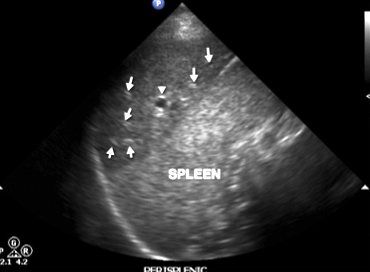I want to share a recent ED case that got me thinking.
CASE: 38F with alcoholic use disorder presenting with a mildly tender but very distended abdomen. I put the probe on her and see this…

The diagnosis was not hard. I expected to see ascites but her LUQ view puzzled me. What am I looking at?
ANSWER: ascites AND a beaver tail liver.
Beaver tail liver (aka wrap around liver or sliver of liver) is an anatomic variant of the liver that can sometimes cause confusion. Here, an elongated left lobe of the liver extends laterally across the midline and often drapes over the spleen, resembling the tail of a beaver and so, the name (Fig. 1). Sonographically, it will appear as a hypoechoic, crescent-shaped area cephalad to the spleen (Video 1). There is a female predominance. This left lobe is composed of normal liver parenchyma and has no additional risk of pathology. Theoretically, it may be more prone to injury following trauma to the left lower chest or left upper quadrant.

Liver and spleen share similar echogenicity so it can be challenging to differentiate the two organs from each other. However, the main reason to be aware of the beaver tail liver is that it can mimic a subcapsular splenic hematoma and less often, a splenic mass on point-of-care ultrasound (Fig. 2). If we are not familiar with its sonographic appearance and (lack of) clinical significance, the patient may undergo unwarranted operative interventions.

A trick you can try is to visualize the normal hepatic +/- portal veins in 2D (Fig. 3), which can be made more obvious with color Doppler (Fig. 4). Alternatively, try to angle the probe anteriorly or rotate 90deg to determine if this region is contiguous with the right lobe of the liver. If you are still unsure, then proceed with further imaging.


So next time you see a funny LUQ view like this, pause and think about whether it could be a nod to a certain furry friend. Good luck scanning!
References
- Xiang H, Han J, Ridley WE, Ridley LJ. Beaver tail liver: Anatomic variant. Journal of Medical Imaging and Radiation Oncology. 2018; 62(1): 57-57.
- Atalar MH, Karakus K. Beaver tail liver. Abdominal Radiology. 2017; 43(7): 1851-1852.
- Glennison M, Salloum C, Lim C, et al. Accessory liver lobes: anatomical description and clinical implications. J Visc Surg. 2014; 151(6): 451–455.
- Jones R, Tabbut M, Gramer D. Elongated left lobe of the liver mimicking a subcapsular hematoma of the spleen on the focused assessment with sonography for trauma exam. Am J Emerg Med. 2014; 32(7):814.e3–814.e4.
- Crivello MS, Peterson IM, Austin RM. Left lobe of the liver mimicking perisplenic collections. J Clin Ultrasound. 1986;14(9): 697–701.
- Cholankeril JV, Zamora BO, Ketyer S. Left lobe of the liver draping around the spleen: a pitfall in computed tomography diagnosis of perisplenic hematoma. J Comput Tomogr. 1984; 8(3): 261–267.
- Beavertail: delicious Canadian pastry or POCUS pitfall? - December 2, 2020



3 Comments
Awesome case. I love the beaver tail with the nutella topping, but plain cinnamon sugar beaver tails are delicious too. I personally would like to see more food related POCUS cases.
Amazing Dr.Chan. Thank you for sharing the US.
Excellent images and explanation. Never heard of this and not sure if I have ever misinterpreted these findings on POCUS. I should remember it with this name too!